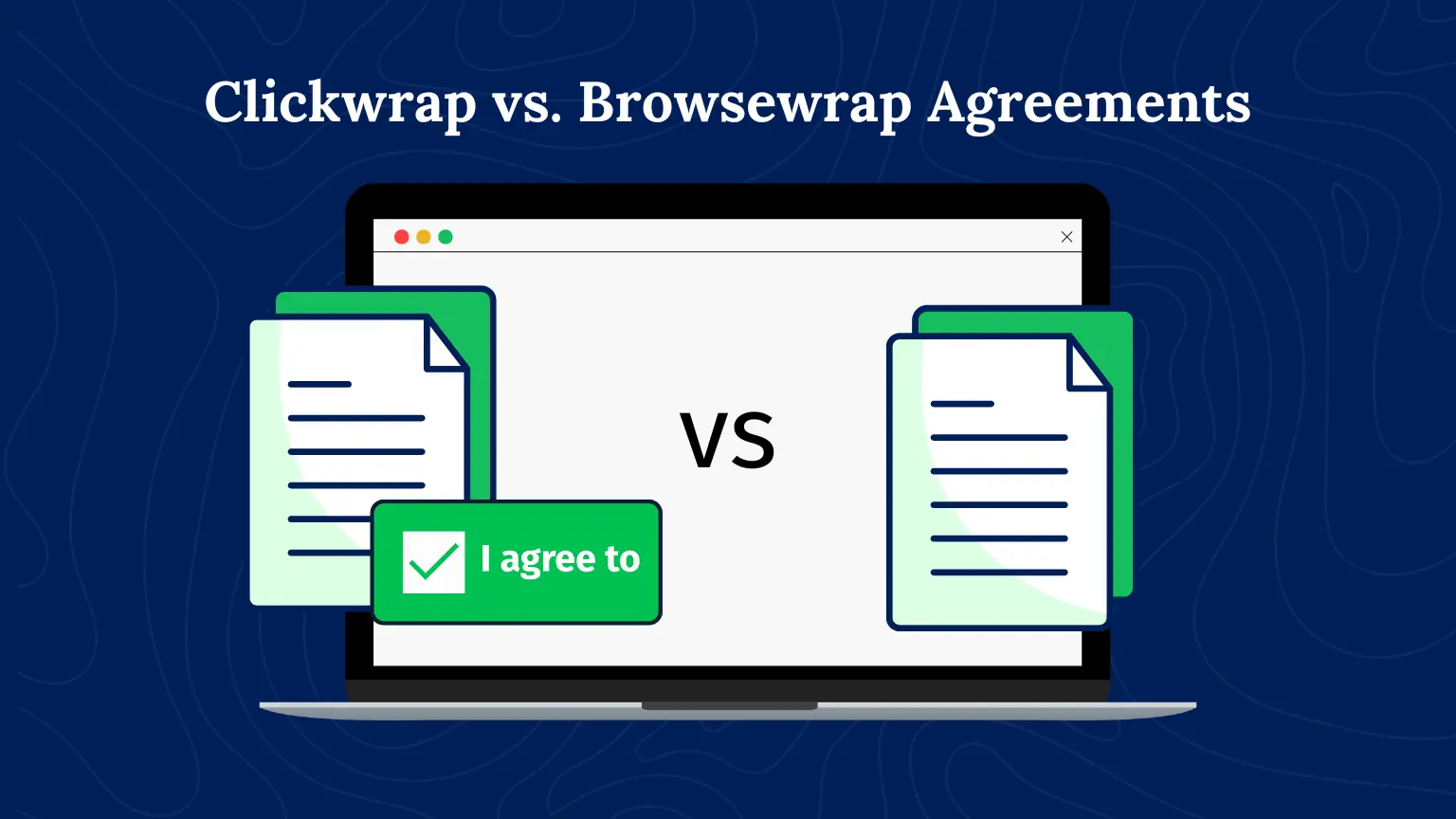
Understanding the difference between Clickwrap and Browsewrap Agreements
Imagine this: you’ve just created your dream website, but mentioning those annoying terms and conditions makes you shiver.
How do you avoid legal dangers and ensure people accept your terms?
Explore the realm of browsewrap and clickwrap agreements!
These are the two most famous and commonly used online contracts or agreements online companies use.
Their power and versatility allow them to speed up the contract management lifecycle by streamlining the signature process.
Clickwrap requires users to click a button or check a box to express their agreement.
With Browsewrap, accepting a contract is considerably easier, and users don’t need to click or check a box.
Instead, users are immediately considered to have accepted such an agreement by accessing the website.
However, compared to Browsewrap, clickwrap agreements have a higher chance of being enforced in court.
While many companies still present their agreements via Browsewrap, they are typically unenforceable.
This blog post is a comprehensive guide for learning about these online contracts (e-contracts), how they affect the user experience, and, most importantly, whether they are legally enforceable.
We’ll study each agreement’s specifics, consider whether they may be enforced under data privacy laws like the CCPA and GDPR, and provide the information you need to select the most suitable agreement for your requirements.
What are e-contracts?
E-contracts are foreign-born cousins of contracts who returned with new electronics and a fancy name.
These days, electronic contracts, which are contracts in a digital form—are in demand.
The primary difference between e-contracts and traditional contracts is that the former occurs via an online digital communication channel.
The role of intermediaries has been replaced by e-contracts, which allow vendors to communicate directly with customers.
These days, intermediaries are computer programs that link buyers and sellers to electronic agents or apps.
It provides a setting for the buyer and the seller to communicate.
Clickwrap vs Browsewrap
Before thoroughly analyzing their similarities and differences, let’s explore the terms, functions, benefits, and drawbacks of clickwrap and browsewrap agreements.
We’ll also examine sign-up wrap, a combination of Browsewrap and Clickwrap.
What is a Clickwrap Agreement?
Clickwrap agreements, also called click-to-sign, click-accept, or clickthrough agreements, are electronic contracts that users can accept by clicking a button or checking a box.
Compared to traditional digital contracts, which require users to physically sign a document or insert their signature using Word, Adobe Acrobat, or another word processor, these require significantly less effort to sign.
In general, Clickwrap can be used for all types of commercial contracts.
They work best, though, with standardized contracts—low-or-no-negotiation agreements that many parties may accept using the same language at once.
NDAs, influencer agreements, and terms of service agreements are a few examples of these.
How does the Clickwrap Agreement function?
- Presentation: Before using a website, app, software, or digital service, the terms and conditions are prominently displayed.
- Active Consent: To expressly accept the terms and conditions, users must click a button or check a box. This may be an “I Agree” button or a “Accept Terms” checkbox.
- Consent Record: A digital trail of the user’s acceptance is created by recording the click or checkbox action.
Benefits of Clickwrap Agreements
- Clear Evidence of User Awareness and Consent: The active click offers strong proof of user awareness and consent, which facilitates the agreement’s legal enforcement.
- Transparency: Clickwrap agreements usually provide the terms and conditions in easy-to-understand language, lowering the possibility of misunderstandings.
- User Control: Before continuing, users are given the choice to agree or reject the terms explicitly.
Drawbacks of Clickwrap Agreements
- Possibility of User Fatigue: If users click mindlessly without carefully reading the terms and conditions, it could result in future legal issues.
- Accessibility Issues: Clickwrap agreements can be challenging to navigate for people with disabilities or low knowledge of technology.
- Over-reliance on technology: If a button doesn’t work or there are technical issues, the user’s consent could be invalid.
What is a Browsewrap Agreement?
By using or accessing a website or digital service, users are considered to have accepted the terms and conditions of the agreement, known as a browsewrap.
Browsewrap agreements function under the assumption that users are aware of the terms and agree to them by continuing to browse or use the platform, in contrast to clickwrap agreements, which need an active confirmation.
Browsewrap agreements, commonly used for Terms of Service agreements, inform users about the contract through notices such as banners and hyperlinks.
Nevertheless, the majority of browsewrap contracts aren’t enforceable in court.
This is because users:
- Don’t spend time reading the banner or clicking on the hyperlink.
- Are unable to provide proof of their consent to the contract.
How does the Browsewrap Agreement function?
- The presence of T&Cs: A hyperlink or other similar element on the website or platform provides access to the T&Cs. They are usually available at the footer of websites or when creating accounts.
- Passive Consent: Users do not explicitly need to do anything to show that they accept the terms and conditions. Instead, it is assumed to be accepted if they keep using the website or service.
- Enforceability Challenges: It may be harder to prove that users understood and consented to browsewrap agreements than clickwrap agreements, so browsewrap agreements may be more complex to enforce.
Benefits of Browsewrap Agreement
- Simplified User Experience: A more seamless user experience is made possible by browsewrap agreements, which do not interfere with user navigation or website engagement.
Drawbacks of Browsewrap Agreement
- Enforceability Issues: It can be challenging to prove that users understood and consented to the terms because they aren’t required to express their consent explicitly.
- Ambiguity and Misunderstandings: There may be disagreements or misunderstandings regarding user consent due to variations in the T&Cs’ placement and visibility.
- Limited User Choice: Because they are bound to abide by the terms of the agreement even if they haven’t explicitly agreed to them, users may feel they have little control over them.
What is a sign-in wrap?
A hybrid of Clickwrap and Browsewrap, sign-in-wrap collects contract acceptance by performing an additional action, such as logging in or signing up.
Sign-in-wrap agreements are less likely to be enforced than clickwrap agreements due to their dual purpose of allowing users to accept terms and sign in by clicking a button.
Still, the courts often consider them more favorably than browsewrap agreements.
Similarities between Clickwrap and Browsewrap
Clickwrap and Browsewrap share a few similarities, which are as follows:
- Both are mediums for presenting online agreements.
First off, both are formats for presenting online agreements: Clickwrap and Browsewrap.
These replace traditional methods like emailing or hyperlinking a Word or PDF contract.
For this reason, Browsewrap and Clickwrap can be time-saving.
- Both are ESIGN and UETA-compliant
Both Browsewrap and Clickwrap are approved by the Uniform Electronic Transactions Act (UETA) and the Electronic Signatures in Global National Commerce (ESIGN) Act.
The ESIGN Act is federal legislation in the United States, and all the states except New York have adopted UETA.
- Everywhere, businesses use both.
Lastly, businesses worldwide use both widely as they are simple to use and accelerate the contract execution and signing process.
Both Clickwrap and Browsewrap are commonly used for low-or-no-negotiation agreements, including privacy policies and terms of service agreements that use similar or the same language for every user.
Differences between Clickwrap and Browsewrap
Despite several similarities, both Clickwrap and Browsewrap have several differences too, which are as follows:
Differences in how they are presented and agreed to
When dealing with Clickwrap and Browsewrap, one of the first things you’ll notice is how different they are presented.
Clickwrap demands more from you and your users than Browsewrap does.
For consumers to provide their affirmative consent, you must give them two components:
- A web link or summary of the agreement that users are accepting
- A checkbox or button that users may click to confirm their consent.
Although Browsewrap has the first part, it does not have the second.
While Clickwrap requires users to agree by clicking or explicitly checking a box, Browsewrap assumes users have provided their consent simply by using the website.
The user has the option to decline consent by closing the window.
However, besides exiting the website, Browsewrap does not provide a straightforward method for users to opt out of consent to an agreement.
Clickwrap requires users to check a box or click a button to agree affirmatively.
Signers do not need to do anything to use Browsewrap.
In a nutshell, Browsewrap relies on assumed or implied agreement rather than explicit consent.
Enforceability
The Clickwrap Litigation Trends study indicates that the enforceability rates of browsewrap and clickwrap agreements differed significantly.
In recent years, Browsewraps had only a 14% success rate.
This is so that the user can accept Browsewrap’s conditions without having to take affirmative action because Browsewrap relies on implied consent.
Clickwrap, on the other hand, notifies users of the existence of a contract and gets their express consent to its conditions.
As per the legal system, consent becomes enforceable only when both conditions are satisfied.
The court cannot enforce the contract if just one condition is satisfied.
Only when browsewrap agreements provide users actual notice of the agreement can they be enforced.
It isn’t easy to prove since browsewrap agreements provide actual notice only if:
The user admits that they were aware of the terms.
The website states that it sent the user an online agreement (for example, via email or a cease-and-desist letter).
Clickwrap follows best practices, but Browsewrap does not.
Lastly, Browsewrap does not conform to best practices, whereas Clickwrap does. According to Clickwrap’s best practices, you must:
- Give each user clear notice of the conditions they are accepting.
- Require explicit, affirmative consent from each user for the conditions of your agreement.
- Whenever you update or change the terms of your agreement, get the user’s consent first.
- Keep clear audit trails demonstrating when and how you agreed to your terms.
By comparison, Browsewrap does not require or encourage any of these actions.
Under Browsewrap, you cannot keep or generate records to demonstrate who agreed to the terms.
Users can sign your agreement at any time without having to do anything.
Thus, you cannot verify who signed it or when.
This is yet another reason why browsewrap agreements are unenforceable.
Which agreement is more enforceable?
Because they offer stronger proof of user consent than browsewrap agreements, clickwrap agreements are typically regarded as being more enforceable.
In contrast to Browsewrap, which takes a passive approach, Clickwrap requires a conscious action, such as clicking a checkbox. This indicates being aware and knowing intention.
Furthermore, Clickwrap displays the terms, so users have a reasonable opportunity to read and fully understand them before consenting.
Browsewrap makes the terms tricky by hiding them in menus and legalese.
In contrast to Browsewrap, which feels forced in its implied agreement, Clickwrap gives users a clear choice to accept or decline.
Ultimately, Clickwrap creates a digital record of consent, while Browsewrap doesn’t provide evidence that consumers were even aware of the terms.
However, enforceability can change depending on situations and legal settings.
It’s important to remember that enforceability can also be influenced by situations, existing court decisions, and the jurisdiction in which the disagreement occurs.
Browsewrap agreements are subject to stricter regulations in several countries, and depending on the circumstances, exceptions may be made to their enforceability.
Conclusion
When comparing Clickwrap versus Browsewrap, Clickwrap comes out on top overall.
Although you and your users can save much time using both digital signing methods, Clickwrap has a higher success percentage in court.
Users must express their affirmative consent to terms under Clickwrap, unlike Browsewrap, which depends on implied consent.
You must give them a button or checkbox they can click on to confirm their consent.
Put otherwise, Clickwrap makes proving appropriate notice and permission much simpler.
To optimize your contract management workflow, use Clickwrap rather than Browsewrap.



